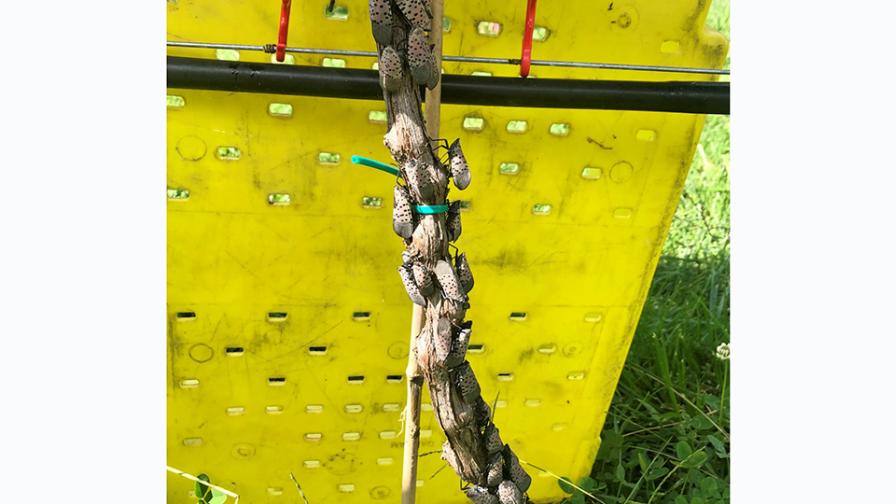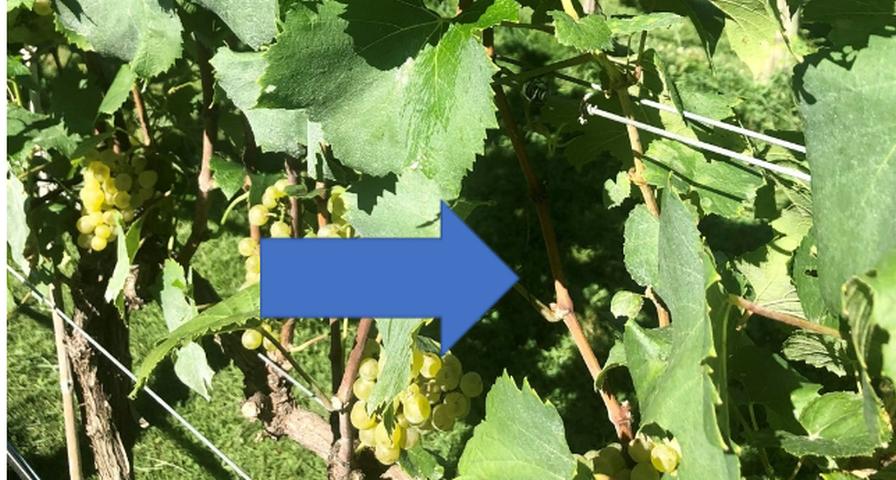Dear Diary: Virginia Grape Growers Ready To Take On Spotted Lanternfly Scourge

Spotted lanternfly adults on a grapevine trunk at harvest 2022, Winchester (Virginia) Association for Rural Environmental Care.
Photo by Tremain Hatch
Most of you have heard about Spotted Lanternfly (SLF), an invasive species that was found in the Mid-Atlantic in 2014. This phloem-feeding insect excretes a large amount of honeydew, which can mold and attract sugar-seeking insects. It’s an aggravating insect because it is problematic in agricultural production systems as well as for residents.
SLF feed on a great number of plants, but grapevines are a preferred host, so vineyardists are particularly nervous about the spread of this invasive insect. Unfortunately, the spread across much of the nation is likely. If it’s not on your radar now, it will likely be over the next couple years.
SLF is a great hitchhiker; automobiles, rail cars or even harvest bins provide a way to move egg masses into new areas. At this point in Virginia, Spotted lanternfly has been found in a handful of our American Viticultural Areas, so it will likely become a vineyard pest across all vineyards in the commonwealth in the next
couple years.
A quick review of the timeline of SLF at the Association for Rural Environmental Care (AREC) near Winchester, VA:
• Fall 2014 – SLF identified in eastern Pennsylvania
• January 2018 – SLF first identified in Winchester, VA (10 miles north of AREC)
• Fall 2021 – we saw a couple adults around harvest time in the AREC vineyard
• Spring 2022 – we had a couple egg masses emerge in the vineyard (note: these were right in front of us during pruning and we did not see them)
• August 2022 – our vineyard was inundated with SLF adults
A couple notes to provide context about the Winchester AREC. The station is approximately 10 miles south of Winchester where SLF was first found in 2018. Diligent work by the Virginia Department of Agriculture and Consumer Sciences helped curb the rate of spread from Winchester.

Honeydew (identified with blue arrow) on a ‘Chardonnay’ vine, Sept. 2022, Winchester Association for Rural Environmental Care.
Photo by Tremain Hatch
PREFERRED HOST NO. 2
Tree of Heaven is another preferred host for SLF. For those of you with vineyards that do not yet have SLF, I think it is appropriate to create an inventory of Tree of Heaven around your vineyard. An aggressive move would be to kill the Tree of Heaven around your vineyard, or at least flag these trees to use as scouting sentinels.
The AREC has Tree of Heaven in two separate stands adjacent to our vineyard. Late in the summer of 2022, the numbers of adult SLF in our vineyard were on par with a modest Japanese Beetle infestation. We made two insecticide applications in the vineyard, but the SLF move in from adjacent areas rapidly following insecticide applications. We had high numbers of adults in the canopy.
By late August, we had high amounts of honeydew on the top of the canopy and a modest amount of honeydew on the fruit. We anticipate that most of the vineyards in the state will start to see SLF in their vineyards over the next couple seasons.
Fortunately, there is good IPM for SLF, including land grant institutions, state/local and federal support, as well as communication channels through grower organizations. We have a vetted toolbox of insecticides to use, as well as thresholds and other practices that will help us control this pest.
It’s anxiety inducing to have a new insect pest to manage; however, we are fortunate to learn from growers who have been growing in the midst of SLF for a number of years in Southeast Pennsylvania. It’s comforting to know our colleagues in Pennsylvania have faced SLF in some of their vineyard areas and are feeling more comfortable about how to control this pest.










